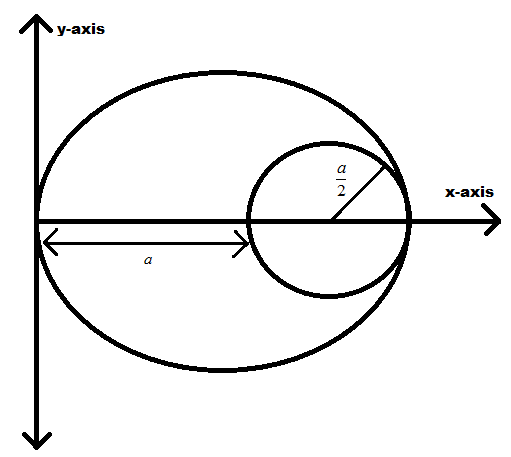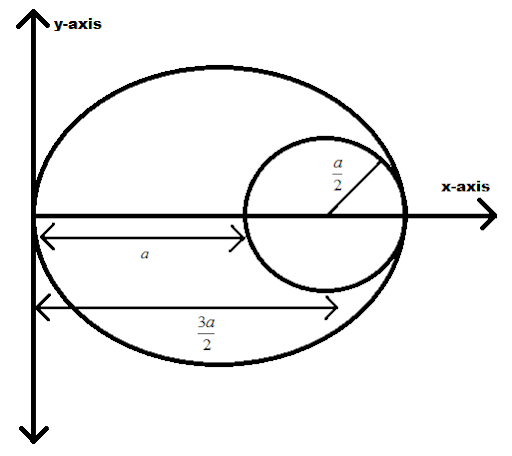
A circular hole of radius $\left( {\dfrac{a}{2}} \right)$ is cut out of a circular disc of radius ‘a’ shown in the figure. The centroid of the remaining circular portion with respect to point ‘O’ will be.
A. $\dfrac{{10a}}{{11}}$
B. $\dfrac{{2a}}{3}$
C. $\dfrac{a}{6}$
D. $\dfrac{{5a}}{6}$

Answer
218.7k+ views
Hint: Centroid is defined as the arithmetic means of all the points in the figure and it is also known as the center point of the given-on object. It always lies in the inside of an object.
In the question, we have a circle which is having a hole inside it and a radius $\left( {\dfrac{a}{2}} \right)$, it is
cut out from a circular disc. So, we have to use the centroid formula of the circle.
Formula used : The centroid is written as;
${X_{com}} = \dfrac{{{m_1}{x_1} - {m_2}{x_2}}}{{{m_1} - {m_2}}}$
Here, ${m_1}{\text{ and }}{m_2}$is the moment and ${x_1}{\text{ and }}{x_2}$ is the point.
For circle, $m = \sigma \pi {r^2}$
Where, $\sigma $ is the surface mass density of a disc.
Complete step by step solution:
To know about the distance between the circle along the x-axis and touch the y-axis let us find it with the help of the figure. The figure is shown below,

Here, as we see that the radius of the inner circle is $\left( {\dfrac{a}{2}} \right)$ and the outer circle radius is “a”, therefore it will be;
$a + \dfrac{a}{2} = \dfrac{{3a}}{2}$
Now we have the distance of two circles as “a” and “$\left( {\dfrac{{3a}}{2}} \right)$”.
Now, let us calculate the moment for the outer and the inner circles.
For the outer circle moment,${m_1}$ is written as;
${m_1} = \sigma \pi {a^2}$
For the inner circle, the moment is ${m_2}$;
${m_2} = \sigma \pi {\left( {\dfrac{a}{2}} \right)^2} \\
\Rightarrow {m_2} = \sigma \pi \dfrac{{{a^2}}}{4} \\ $
Now, putting these values in ${X_{com}} = \dfrac{{{m_1}{x_1} - {m_2}{x_2}}}{{{m_1} - {m_2}}}$ we have;
${X_{com}} = \dfrac{{(\sigma \pi {a^2})a - \left( {\sigma \pi \dfrac{{{a^2}}}{4}} \right)\left( {\dfrac{{3a}}{2}} \right)}}{{\sigma \pi {a^2} - \sigma \pi \dfrac{{{a^2}}}{4}}} \\
\Rightarrow {X_{com}} = \dfrac{{\sigma \pi {a^3} - \left( {\sigma \pi \dfrac{{3{a^3}}}{8}} \right)}}{{\dfrac{{4\sigma \pi {a^2} - \sigma \pi {a^2}}}{4}}} \\
\Rightarrow {X_{com}} = \dfrac{{\dfrac{{8\sigma \pi {a^3} - \left( {3\sigma \pi {a^3}} \right)}}{8}}}{{\dfrac{{4\sigma \pi {a^2} - \sigma \pi {a^2}}}{4}}} \\ $
Further solving,
$\Rightarrow {X_{com}} = \dfrac{{\dfrac{{5\sigma \pi {a^3}}}{8}}}{{\dfrac{{3\sigma \pi {a^2}}}{4}}} \\
\Rightarrow {X_{com}} = \dfrac{{5a}}{6} $
Hence, option D is correct
Note: The centroid is the center of the object and it is also called the center of gravity. It should always lie inside the object. The centroid is having a different surface mass density. According to the shape of the object surface density varies.
In the question, we have a circle which is having a hole inside it and a radius $\left( {\dfrac{a}{2}} \right)$, it is
cut out from a circular disc. So, we have to use the centroid formula of the circle.
Formula used : The centroid is written as;
${X_{com}} = \dfrac{{{m_1}{x_1} - {m_2}{x_2}}}{{{m_1} - {m_2}}}$
Here, ${m_1}{\text{ and }}{m_2}$is the moment and ${x_1}{\text{ and }}{x_2}$ is the point.
For circle, $m = \sigma \pi {r^2}$
Where, $\sigma $ is the surface mass density of a disc.
Complete step by step solution:
To know about the distance between the circle along the x-axis and touch the y-axis let us find it with the help of the figure. The figure is shown below,

Here, as we see that the radius of the inner circle is $\left( {\dfrac{a}{2}} \right)$ and the outer circle radius is “a”, therefore it will be;
$a + \dfrac{a}{2} = \dfrac{{3a}}{2}$
Now we have the distance of two circles as “a” and “$\left( {\dfrac{{3a}}{2}} \right)$”.
Now, let us calculate the moment for the outer and the inner circles.
For the outer circle moment,${m_1}$ is written as;
${m_1} = \sigma \pi {a^2}$
For the inner circle, the moment is ${m_2}$;
${m_2} = \sigma \pi {\left( {\dfrac{a}{2}} \right)^2} \\
\Rightarrow {m_2} = \sigma \pi \dfrac{{{a^2}}}{4} \\ $
Now, putting these values in ${X_{com}} = \dfrac{{{m_1}{x_1} - {m_2}{x_2}}}{{{m_1} - {m_2}}}$ we have;
${X_{com}} = \dfrac{{(\sigma \pi {a^2})a - \left( {\sigma \pi \dfrac{{{a^2}}}{4}} \right)\left( {\dfrac{{3a}}{2}} \right)}}{{\sigma \pi {a^2} - \sigma \pi \dfrac{{{a^2}}}{4}}} \\
\Rightarrow {X_{com}} = \dfrac{{\sigma \pi {a^3} - \left( {\sigma \pi \dfrac{{3{a^3}}}{8}} \right)}}{{\dfrac{{4\sigma \pi {a^2} - \sigma \pi {a^2}}}{4}}} \\
\Rightarrow {X_{com}} = \dfrac{{\dfrac{{8\sigma \pi {a^3} - \left( {3\sigma \pi {a^3}} \right)}}{8}}}{{\dfrac{{4\sigma \pi {a^2} - \sigma \pi {a^2}}}{4}}} \\ $
Further solving,
$\Rightarrow {X_{com}} = \dfrac{{\dfrac{{5\sigma \pi {a^3}}}{8}}}{{\dfrac{{3\sigma \pi {a^2}}}{4}}} \\
\Rightarrow {X_{com}} = \dfrac{{5a}}{6} $
Hence, option D is correct
Note: The centroid is the center of the object and it is also called the center of gravity. It should always lie inside the object. The centroid is having a different surface mass density. According to the shape of the object surface density varies.
Recently Updated Pages
Two discs which are rotating about their respective class 11 physics JEE_Main

A ladder rests against a frictionless vertical wall class 11 physics JEE_Main

Two simple pendulums of lengths 1 m and 16 m respectively class 11 physics JEE_Main

The slopes of isothermal and adiabatic curves are related class 11 physics JEE_Main

A trolly falling freely on an inclined plane as shown class 11 physics JEE_Main

The masses M1 and M2M2 M1 are released from rest Using class 11 physics JEE_Main

Trending doubts
JEE Main 2026: Application Form Open, Exam Dates, Syllabus, Eligibility & Question Papers

Derivation of Equation of Trajectory Explained for Students

Hybridisation in Chemistry – Concept, Types & Applications

Understanding the Angle of Deviation in a Prism

Understanding Collisions: Types and Examples for Students

Understanding Atomic Structure for Beginners

Other Pages
JEE Advanced Marks vs Ranks 2025: Understanding Category-wise Qualifying Marks and Previous Year Cut-offs

Units And Measurements Class 11 Physics Chapter 1 CBSE Notes - 2025-26

NCERT Solutions For Class 11 Physics Chapter 8 Mechanical Properties Of Solids

Motion in a Straight Line Class 11 Physics Chapter 2 CBSE Notes - 2025-26

NCERT Solutions for Class 11 Physics Chapter 7 Gravitation 2025-26

How to Convert a Galvanometer into an Ammeter or Voltmeter




